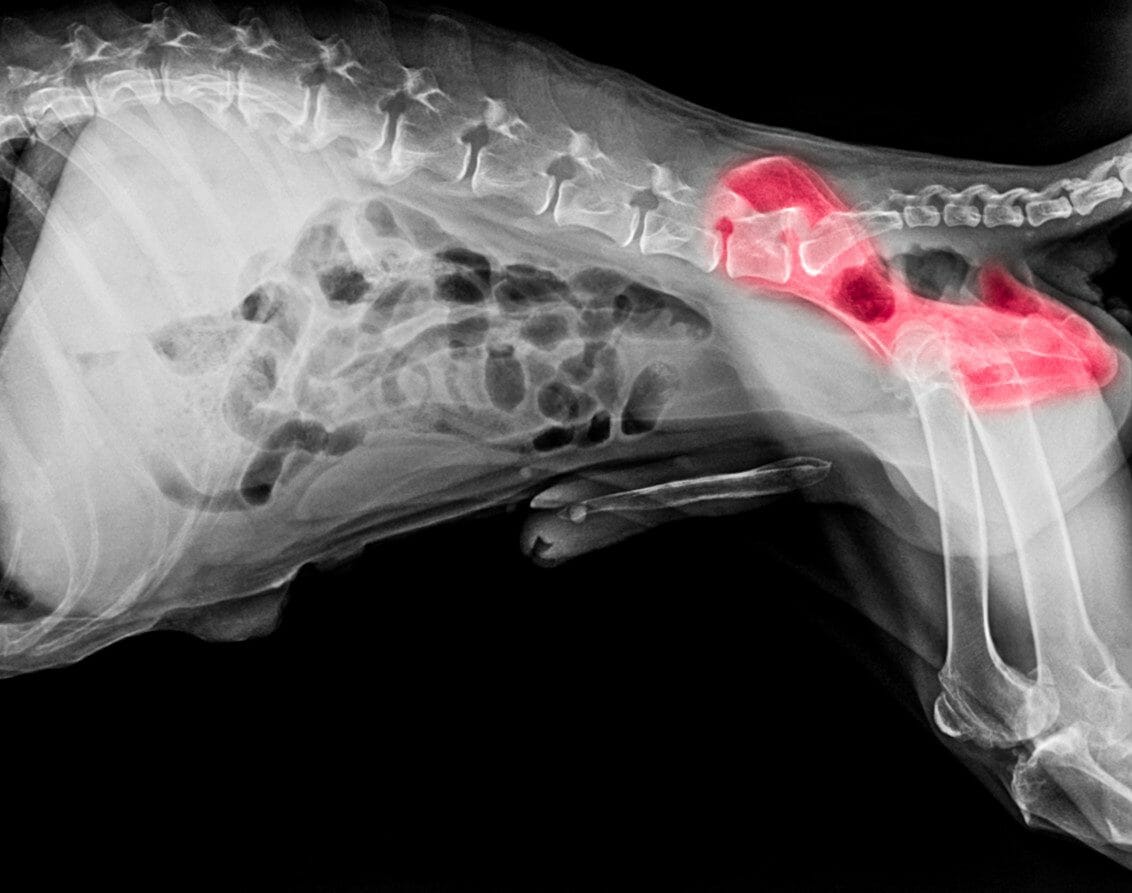What Is Hip Dysplasia in Dogs?
Hip dysplasia in dogs is a condition most often found in larger breeds of canines. The problem occurs because of the abnormal development of one, or both, of a dog’s hip joints while it is still a puppy. This can be very painful to the dog and can have a serious impact on its quality of life.
To develop an understanding of the condition, it is important to first learn how a dog’s hip joint works. The hip joint of a dog consists of a ball and socket. When a dog develops hip dysplasia, the ball no longer fits the socket. When this occurs, the ball does not move smoothly within the joint. After repeated grinding over a period of time, the joint will deteriorate. This can lead to the dog losing the ability to use the joint at all.

What Are the Symptoms of Hip Dysplasia in Dogs?
From around four months old, a puppy may start to display signs of this debilitating condition. However, some dogs will develop the condition along with osteoarthritis as they get older. In either case, the signs of hip dysplasia in dogs that owners need to be aware of include:
- Reduced activity levels
- Sway in the dog’s gait
- “Bunny hopping”
- A loss of mass in the thigh muscles
- Limited motion
- A grating sound from the hip during movement
- Limping
- Stiffness of movement
- Enlarged shoulder muscles
- Weakness in the hind legs
Although puppyhood is the typical time for this condition to develop, some canines will not exhibit symptoms until they are much older. With some dogs, the symptoms will not appear until the bones begin to deteriorate substantially. The early signs of hip dysplasia in dogs should not be ignored. Owners that suspect a dog has the condition should make an appointment with a veterinarian at the earliest opportunity.

What Causes Hip Dysplasia in Dogs?
Certain dogs are pre-disposed to developing this condition, but is hip dysplasia genetic in dogs? Although this condition can be hereditary, there are several other factors that lead to the condition in canines. A poor diet, lack of exercise, or too much exercise can all play a part in a dog’s hip joints wearing down.
Many puppies have specific nutritional needs. For this reason, it is recommended that puppies from larger breeds eat a specially formulated diet that will reduce the risk of excessively rapid growth that could bring about skeletal disorders such as hip dysplasia. By slowing down a puppy’s growth, the joints will be able to develop without excessive strain being applied to them.
Which Dog Breeds Are Most Prone to Hip Dysplasia?
Although any dog, regardless of its size, can develop hip dysplasia, it is a condition that tends to affect larger breeds. Particular breeds of dogs prone to hip dysplasia include:
- German Shepherds
- Dobermans
- Labrador Retrievers
- Golden Retrievers
- Rottweilers
- Saint Bernard’s
- Great Danes
Large mixed breeds are also at a higher risk of developing the condition.

How Is Hip Dysplasia Diagnosed?
A vet will formally diagnose a dog after a physical examination and X-rays. During the exam, the vet will move the dog’s legs around in the hip joint to check for signs of grinding, limited motion, or pain. The vet may also take blood as a canine’s blood may show signs of disease in the joints. X-rays will be taken while the dog is under anesthesia. Once the vet has images of the dog’s joints, a treatment plan can be put into place.
How Long Can a Dog Live with Hip Dysplasia?
If a dog receives appropriate treatment and the condition is managed through diet and exercise, the prognosis is generally good. It is possible for a dog with the condition to go on to live a long and full life. An understanding of the condition, being alert for signs of the condition from a young age, and ensuring appropriate actions are taken promptly are all things that owners should be doing, especially when the breed is more susceptible to hip dysplasia.

How to Treat Hip Dysplasia in Dogs
There are several ways hip dysplasia can be treated in dogs depending on the severity of the case. These range from changes in the dog’s lifestyle to surgery.
In mild cases, a veterinarian may recommend the following:
- Putting the dog on a diet to reduce the strain on the hips
- Undergoing physical therapy
- Using anti-inflammatory medications
- Using a dog hip dysplasia brace
When a vet diagnoses severe hip dysplasia in dogs, surgery will be essential. There are several different surgeries used for treating affected dogs. These include:
- A double or triple pelvic osteotomy
- Femoral head ostectomy
- Hip replacement

Younger dogs under the age of 10 months are usually the best candidates for a double or triple pelvic osteotomy. By cutting and rotating sections of the pelvic bone, it is possible to improve the function of the joint.
A femoral head ostectomy is suitable for dogs of all ages and involves the femoral head (or the ball) being removed. This creates a false hip joint that will not be as painful for the dog. The downside to the procedure is that the joint will not have full function.
Hip replacement is the surgery that offers the best outcomes. By replacing the joint with a plastic or metal one, it is possible for the dog to retain full movement and live a pain-free life.
The dog hip dysplasia surgery cost can be high, so it is recommended that owners purchase adequate pet insurance when buying or adopting to reduce the financial burden associated with vets’ bills.
How to Prevent Hip Dysplasia in Dogs
It is not possible to completely avoid hip dysplasia. However, there are measures that may be taken to limit a dog’s chances of developing the condition. For example, as a puppy grows, owners should ensure that it is fed appropriately so that bones and joints develop at a proportionate rate. In addition to this, making sure a dog gets daily exercise will help prevent obesity as excess weight can put additional pressure on the joints. Preventing hip dysplasia in dogs, particularly those in the higher risk category such as German Shepherds, is a responsibility that all owners should take seriously.



